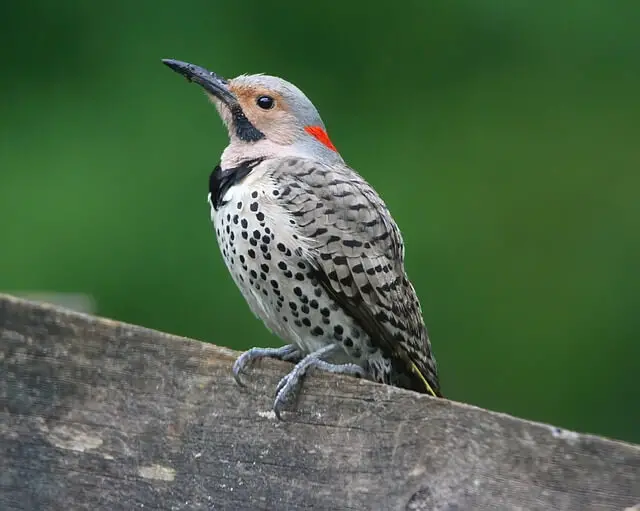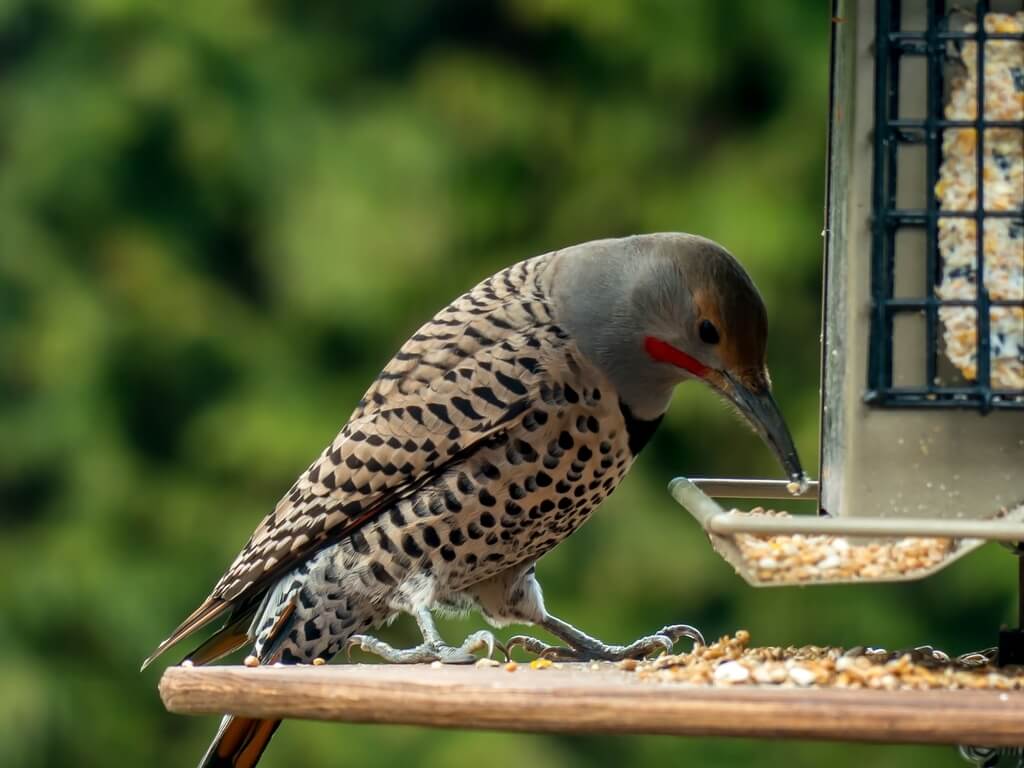
If you want to add a little variety to your backyard birdwatching, why not try attracting Northern Flickers? These striking woodpeckers are not only fun to watch, but they can also help control insect populations. Here are a few tips on how to attract northern flickers to your backyard.
Table of Contents
- 1 Best time to Feed Northern Flickers
- 2 Attracting Northern Flickers with Flowers and Berries
- 3 Northern Flickers like clean yards
- 4 Attract Northern Flickers with a freshly cut lawn
- 5 Attracting Northern Flickers to your bird feeder
- 6 Provide Shelter for the Northern Flicker
- 7 Northern Flickers love Bird Baths
- 8 Northern Flickers eat Seeds and Nectar
- 9 Feed Northern Flickers Peanut Butter
- 10 Use Pine Cones and Wood Chips
- 11 Plant some Flowers, Trees and Shrubs
- 12 Frequently Asked Questions
- 13 Author
Best time to Feed Northern Flickers
To attract Northern Flicker birds to your garden or lawn, you should try using birdseed to attract these species. The best time to feed birds is from late spring to early summer.
This is because when these birds are migrating to warmer climates, they will usually prefer to eat seeds than food that they are not used to eating.
Attracting Northern Flickers with Flowers and Berries
Another way to attract birds to your yard is to plant some nectar producing flowers. Nectar producing flowers are especially good for attracting birds. These flowers are the same type that plants and insects use to feed themselves.
So, the plants, flowers, and other things around your yard that produce nectar can provide the nutrients and minerals that birds need to survive and thrive. Also, this type of gardening provides the birds with food.
Northern Flickers like clean yards
Another of the best ways to attract Northern Flicker birds to your yard is to make sure that it is kept clean and free of any obstructions.
As with any bird that has to travel long distances for food, it can sometimes be very difficult for them to recognize the best sources of food, and it may take them longer to locate it.
Attract Northern Flickers with a freshly cut lawn
Another tip on attracting birds to your yard is to keep the grass short. This can attract birds who are looking for food. When the grass is short, the birds will be more likely to land on the ground and eat.
Attracting Northern Flickers to your bird feeder
You should also be sure to make sure that you are providing your yard a suitable habitat for the Northern Flicker. In order to attract more of them.
A great idea is to purchase a bird feeder. One that I use myself with great success is the Squirrel Buster Suet Squirrel-proof Suet Bird Feeder.
Fill the backyard feeders with suet, shelled peanuts and hulled sunflower seeds. To refill your suet feeder, use the Pine Tree Farms Peanut Butter Suet Cake Wild Bird Food. I found the best deals for both these products on Amazon.

Provide Shelter for the Northern Flicker
One more thing that will attract numerous Northern Flickers to your yard is to provide shelter for them. They need places that they can call their own. They can easily become stressed if they feel like they are in a place where they do not belong.
If you live in an area where the winter temperatures are below freezing, you can encourage the birds to build their nest in the soil around your home. This is a great way to attract Northern Flicker birds into your area.
As you prepare your backyard for nesting, think about creating a warm and inviting area. A warm garden is a great place to begin, but you should add some trees, bushes, and other structures to provide more shelter.
If you’re an animal lover, especially of birds, then you’ll want to get the Coveside Northern Flicker House. Not only is it a beautiful piece to have in your yard, but it will also provide much-needed shelter for the Northern Flicker. Get it now on Amazon for the lowest price.
Northern Flickers love Bird Baths
Northern Flickers love the sound of running water. Having a bird bath in winter does a wonderful job of getting them to visit your yard frequently. Bird Baths do a better job than bird feeders for attracting these birds come winter time.
Northern Flickers eat Seeds and Nectar
You should also make sure that you are keeping food available for these birds. The Northern Flicker likes to eat the seeds and nectar that can be found in the nectar that is contained in many flowers and plants, but if you have too much of this in your yard and garden, you may have a problem attracting the birds to your garden.
Although you may not realize it, the Northern Flicker is a very intelligent bird, and they can often learn to recognize certain things that other birds in your neighborhood may be using as signals.
You should be able to use various types of foods that are known to attract birds. If you have a lot of different kinds of seeds, nuts, and berries available, you will probably find that the Northern Flicker is attracted to them.
Feed Northern Flickers Peanut Butter
Northern Flickers love the taste of peanut butter. A simple way to attract them is by making a DIY pine cone feeder. All you do is get a pine cone and smudge-peanut butter onto the pine cone.
Once you’re done spreading and filling up all the pine cone inside and out with peanut butter you can then hang it from a tree.
Use Pine Cones and Wood Chips
Another of the best ways to attract these birds to your yard is to ensure that you have enough wood chips and small pieces of pine cones where the Northern Flicker can build their nests.
When they are building these nests, they can look at the various flowers and the surrounding trees.
Plant some Flowers, Trees and Shrubs
These are common flowers, trees and shrubs that attract Northern Flickers. The Mulberry tree, Northern Bayberry, American Elderberry, Black gum, Common Juniper, Flowering Dogwood, Hack berry, Oak, Red-Twig Dogwood, Sassafras, Service berry, Sumac, Wild Cherry and the Virginia Creeper.
Frequently Asked Questions
Do Northern Flicker come to feeders?
Many people enjoy attracting northern flickers to their backyard feeder by placing suet or peanut butter at the feeder.
Do Flickers mate for life?
Most people think that animals mate for life, but do flickers really? Flickers are known to live in a pair-bond and defend their territory together. This leads some people to believe that they must mate for life. However, if one bird is removed from the pair, the other will soon find another partner and not return to its original mate.
What kind of suet do Flickers like?
So what kind of suet do flickers like? They prefer suet made from beef fat, or peanut butter and cornmeal.
Woodpeckers and flickers are related, as they are both members of the family Picidae. Woodpeckers are known for their distinctive drumming behavior, while flickers are known for their unique metallic calls.
Do Flickers eat peanuts?
Feeding Flickers peanuts is a good idea because they need to eat these types of nuts. Peanuts are not the only food that they eat, but it’s one of their favorites. Flickers are attracted to peanuts and will come closer to your house or feeder if you put them out.
What month do Northern Flickers nest?
In North America, Northern Flickers typically nest between February and July. The timing of their nesting season varies depending on the location, with northern birds generally nesting later than those in the south.
Are Northern Flickers rare?
Northern Flickers are actually quite widespread and common, despite their somewhat elusive nature. They can be found across North America, from Alaska all the way down to Mexico. Though they may not be the easiest bird to spot, they are certainly not rare by any means.
Do Northern Flickers use birdhouses?
The northern flicker is a large woodpecker that typically nests in trees, making holes in dead wood for its nest. However, this species will also use nest boxes, particularly if there are no suitable trees available. When choosing a nest box for flickers, be sure to select a model that is large enough to accommodate their sizable nests.



